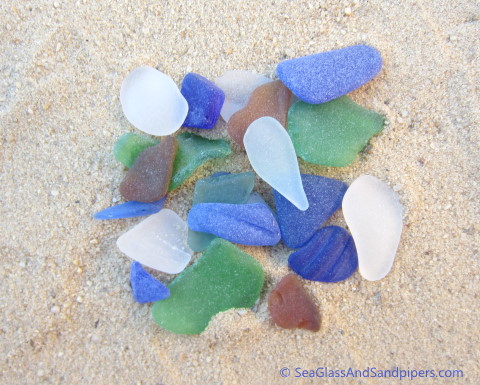Our Beach Blog
What is Sea Glass?

Sea glass begins as just ordinary pieces of broken glass that are rolled and tumbled for years by the ocean, until the sharp edges are smoothed and rounded, and the slickness of the glass has been worn to a smooth, frosted look. It usually originates from bottles or any other glass products that are thrown on the beach or in the ocean. Sometimes these items are thrown overboard from boats or ships, or even in some cases, they are from a town dump or trash heap located too close to the shoreline. So, basically, someone else's trash eventually becomes the beautiful pieces of sea glass so sought after by collectors!
Sea Glass is sometimes also known as beach glass. Though some people use the terms interchangeably, many use the term sea glass for glass found in salt water, and beach glass for fresh water. It typically takes much longer for the glass to transform in fresh water - due to PH differences between fresh and salt water, and often the necessary wave action is much heavier in salt water oceans.
It takes many years, possibly as few as 10, maybe as many as 50 or more, for a good piece of sea glass to be formed. It takes the right combination of surf, sand, and stones to tumble the glass until it is smooth. And, not surprisingly, beaches with more wave activity will transform sea glass more quickly.
The color of sea glass is determined by its original source. So, it is not surprising that the most common colors are green, brown, and white - which typically come from things like soda, juice, beer, and milk bottles. Other not as common colors, such as shades of blue, purple, black, or pink can also be found, but nowhere near as easily as the more common colors. And the most difficult to find due to their extreme rarity are red, yellow, and orange. They're out there, but it takes a good eye and a lot of patience to find them.
As the years pass, Sea Glass is becoming harder and harder to find. The much higher rates of recycling and the increased use of plastic bottles both contribute to this. There is less glass available to be thrown or washed into the ocean.
It seems that more people are looking for sea glass also. Some have spent hundreds of hours walking along the shoreline searching for sea glass. Some people just enjoy the solitude of the search, and for others it just may give some purpose to their daily walk along the shore. Many people enjoy collecting sea glass and just keep it in jars around their home. Others may sell it, or use it to create jewelry or art or other crafts.
There are some areas where finding sea glass is easier, like the northeast coast of the United States. But one of the most popular and well known locations is Fort Bragg, California. This beach was formerly a dumpsite, and is now literally covered with sea glass. But aside from that, the key to finding a good site is to find a beach with big waves. The rough surf is needed to create the sea glass, and areas that are regularly hit with heavy waves produce the best conditions. These rough conditions will also help you to find the sea glass by moving it up onto the shore. The winter or spring is often the best time to look. The ocean is often rougher then, and the best time is around the first low tide after a storm. If you're not familiar with the area, you could ask a local. Just keep in mind that an avid sea glass hunter will never reveal their best hunting spot. Can you blame them?
There is a great book written by Richard LaMotte - "Pure Sea Glass: Discovering Nature's Vanishing Gems". This book is thought by many to be the definitive reference guide to Sea Glass. It covers the history and the process through which it is formed, and provides tips on how and where to find the best pieces. It is also filled with beautiful photographs so in addition to being a source of fascinating information, it makes a great coffee table book.
Recent posts...
Archives...
Popular posts...
